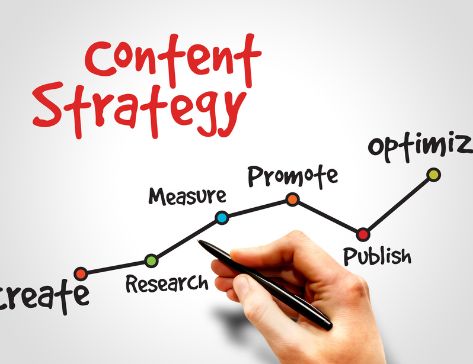
The Ultimate Data-Driven Content Strategy Guide for 2025
A data-driven content strategy transforms how businesses connect with their audiences, turning guesswork into precision and dramatically improving content performance. This comprehensive guide will walk you through the essential steps to develop, implement, and optimize a content strategy that leverages data at every stage, ensuring your content efforts deliver measurable results.

Understanding Data-Driven Content Strategy
At its core, a data-driven content strategy uses analytics and insights to inform content decisions rather than relying on intuition alone. By implementing a data-driven approach, marketers can identify exactly what content resonates with their audience, which channels drive the most engagement, and how content contributes to business objectives.
Unlike traditional content strategies that often follow industry trends or competitor activities, data-driven approaches prioritize audience signals and performance metrics. This shift from assumption-based to evidence-based content creation leads to higher engagement rates, improved conversion metrics, and better ROI on content investments.
Key Benefits of Data-Driven Content Strategy:
- More precise audience targeting and personalization
- Higher content engagement and conversion rates
- Improved content ROI and resource allocation
- Better alignment between content and customer journey
- Continuous optimization based on performance data
Essential Steps to Build Your Data-Driven Content Strategy
1. Establish Clear Content Objectives
Begin by defining specific, measurable goals for your content. These might include:
- Increasing organic traffic by a specific percentage
- Improving conversion rates from content pages
- Boosting engagement metrics (time on page, shares, comments)
- Generating qualified leads through gated content
- Enhancing brand awareness and authority
Each objective should align with broader business goals and include specific KPIs to measure success. This alignment ensures your content strategy directly contributes to business outcomes rather than creating content for content’s sake.
2. Gather and Analyze Audience Data
Comprehensive audience understanding forms the foundation of effective content strategy. Collect and analyze data from multiple sources:
- Website analytics: User behavior, popular content, traffic sources
- Search data: Keywords, search intent, query patterns
- Social listening: Conversations, sentiment, trending topics
- Customer feedback: Surveys, interviews, support interactions
- CRM data: Purchase history, engagement patterns, customer segments
Use this data to create detailed audience personas that go beyond demographics to include content preferences, pain points, information needs, and consumption habits. These data-enriched personas will guide your content creation process.
3. Conduct a Data-Backed Content Audit
Evaluate your existing content through a data lens to identify what’s working and what isn’t. Analyze metrics such as:
- Traffic and traffic sources
- Engagement metrics (bounce rate, time on page, scroll depth)
- Conversion rates and goal completions
- Social shares and backlinks
- Search rankings and visibility
Categorize content into performance tiers (high, medium, low) and identify patterns among top-performing pieces. This analysis reveals content types, topics, formats, and distribution channels that resonate most with your audience, providing a blueprint for future content creation.
4. Develop a Data-Informed Content Plan
Based on your audience insights and content audit, create a strategic content plan that prioritizes high-potential topics and formats. Your plan should include:
- Priority topics based on search volume, competition, and business relevance
- Content formats aligned with audience preferences and channel requirements
- Channel strategy informed by audience behavior and platform analytics
- Content calendar with strategic publishing cadence
- Resource allocation based on projected content performance
Leverage predictive marketing models to forecast content performance and prioritize initiatives with the highest potential impact. This approach ensures efficient resource allocation and maximizes the return on your content investment.
Advanced Data-Driven Content Strategies
Implement Content Personalization
Use behavioral data and user segments to deliver personalized content experiences. Personalization can range from simple dynamic content blocks to sophisticated recommendation engines that serve individualized content based on user history, preferences, and intent signals.
Studies consistently show that personalized content drives higher engagement rates, with personalized calls-to-action converting up to 202% better than generic versions. Implement progressive personalization, starting with simple segmentation and advancing to more sophisticated approaches as you gather more user data.
Optimize Content for Search Intent
Move beyond keyword volume to focus on search intent—the underlying reason behind a user’s search query. Analyze SERP features, competing content, and user behavior to identify the four main types of search intent:
- Informational: Users seeking knowledge or answers
- Navigational: Users looking for a specific website or page
- Commercial: Users researching products before purchasing
- Transactional: Users ready to complete an action or purchase
Align your content format, depth, and structure with the dominant intent for each target keyword. This intent-based approach significantly improves search visibility and user satisfaction.
Leverage Competitive Content Intelligence
Use competitive analysis tools to identify content gaps and opportunities. Analyze competitors’ top-performing content across metrics like organic traffic, backlinks, and social engagement to uncover:
- High-potential topics you haven’t covered
- Content formats driving engagement in your industry
- Keyword opportunities with manageable competition
- Content gaps where audience needs remain unmet
This competitive intelligence helps you develop content that stands out in crowded spaces and captures untapped opportunities your competitors have missed.
Measuring and Optimizing Your Data-Driven Content
Implement Multi-Touch Attribution
Content rarely converts in isolation. Implement multi-touch attribution models that track how content pieces work together throughout the customer journey. This approach helps you understand:
- Which content types are most effective at different funnel stages
- How content sequences influence conversion paths
- The true ROI of top-of-funnel content investments
- Optimal content distribution for nurturing prospects
Advanced analytics platforms and native advertising intelligence tools can help implement these attribution models without requiring extensive technical resources.
Conduct Regular Content Experiments
Implement a systematic testing program to continuously improve content performance. Test variables such as:
- Headlines and meta descriptions
- Content formats and structures
- Call-to-action placement and messaging
- Content length and depth
- Visual elements and multimedia inclusion
Use A/B testing platforms to run controlled experiments and implement the winning variations. This culture of continuous testing ensures your content strategy evolves based on actual performance data rather than assumptions.
Conclusion: The Future of Data-Driven Content
A data-driven content strategy is no longer optional for businesses seeking to maximize their content marketing ROI. By systematically applying data insights throughout the content lifecycle—from planning and creation to distribution and optimization—organizations can create more relevant, engaging content that drives measurable business results.
As technologies like AI and machine learning continue to advance, the potential for data to inform content decisions will only grow. Forward-thinking marketers should embrace data-driven methodologies now to build the foundation for future content success.
Remember that implementing a data-driven content strategy is an iterative process. Start with the fundamentals outlined in this guide, measure your results, and continuously refine your approach based on performance data. With each optimization cycle, your content will become more effective at engaging your audience and driving your business forward.


